As technology continues to advance, more and more people are turning to online tools to create and share presentations. One of the most popular tools for this purpose is Canva, a user-friendly and versatile platform that offers a wide range of features for designing and sharing presentations. Whether you’re a student, a professional, or simply looking to spruce up your personal projects, Canva has something to offer for everyone.
In this article, we’ll dive into the world of Canva presentations and explore how to create and share them effectively. We’ll cover everything from the basics of getting started with Canva to advanced tips and tricks for designing and sharing professional-looking presentations. So let’s get started!

1. Getting Started with Canva Presentations
What is Canva?
Canva is an online graphic design platform that offers a variety of tools and templates for creating different types of visual content, including presentations. It was founded in 2012 and has since gained a massive user base, with over 30 million users worldwide. Canva offers both a free and paid version, with the paid version (known as Canva Pro) offering additional features for professional use.
Creating an Account
To get started with Canva presentations, you’ll need to create a free Canva account. You can sign up using your email address or by connecting your Facebook or Google account. Once you’ve created your account, you’ll have access to Canva’s extensive library of templates and design tools.
Navigating the Interface
Once you’re logged into your Canva account, you’ll be taken to the Canva homepage. Here, you’ll find various options for creating different types of visual content, including presentations. To start creating a presentation, click on the “Presentations” option. This will take you to the presentation templates page, where you can browse through the available templates or search for a specific one.
On the left side of the screen, you’ll find the toolbar, which contains all the design elements you can add to your presentation. These include text boxes, images, shapes, backgrounds, and more. The editing options for each element can be found on the top toolbar.
Choosing a Presentation Template
Canva offers a wide range of presentation templates for different purposes, such as business pitches, educational lectures, project proposals, and more. You can either choose a template from the homepage or search for a specific one using keywords.
When selecting a template, consider the purpose and audience of your presentation. A template that is visually appealing but not relevant to your content may not leave a lasting impression on your audience. You can also choose to start with a blank canvas if you prefer to design your presentation from scratch.
2. Designing Your Presentation

Now that you’ve chosen your template, it’s time to start designing your presentation. Canva offers a variety of tools and features to help you create a professional-looking and visually appealing presentation.
Adding and Editing Text
To add text to your presentation, simply click on the “Text” option in the left toolbar and choose from the available text boxes that appear. You can then type or paste your content into the text box and use the editing options on the top toolbar to customize the font, size, color, alignment, and more.
One useful feature for text is the “Text Effects” option, which allows you to add animations and effects to your text. This can make your presentation more engaging and dynamic. However, use these effects sparingly and only when appropriate, as too many can be distracting.
Inserting Images, Videos, and Other Media
Images and other media can greatly enhance the visual appeal of your presentation. To insert images, click on the “Uploads” option in the left toolbar and select the image you want to use from your computer. Canva also offers a library of free and paid stock images that you can search and use in your presentation.
You can also add videos and other media by clicking on the “Videos” or “Audio” options in the left toolbar. These options allow you to search for and insert videos or audio files from Canva’s library.
Using Layouts and Backgrounds
Canva offers a variety of templates with different layouts and backgrounds, but you can also customize these elements to fit your presentation’s theme. To change the layout, click on the “Layouts” option in the left toolbar and choose a layout that best suits your content.
To change the background of your presentation, click on the “Background” option in the left toolbar. Here, you can choose from solid colors, gradients, patterns, or upload your own background image.
Customizing Fonts and Colors
Consistency in fonts and colors can greatly enhance the overall look of your presentation. Canva allows you to customize your fonts and colors in a variety of ways. You can choose from a wide range of fonts and font combinations, or upload your own custom fonts if you have a Canva Pro account.
To change the color scheme of your presentation, click on the “Colors” option in the left toolbar. Here, you can choose from pre-selected color palettes or create your own custom palette using the color wheel.
3. Collaborating on Presentations

One of the great features of Canva presentations is the ability to collaborate with others in real-time. This makes it an excellent tool for group projects, team meetings, and other collaborative presentations.
Inviting Team Members to Edit
To invite team members to edit your presentation, click on the “Share” button on the top right corner of the screen and select “Collaborate.” Here, you can enter the email addresses of your team members and choose whether they can view, comment, or edit the presentation.
Tracking Changes and Revisions
Canva also offers a feature that allows you to track changes and revisions made by different team members. To access this feature, click on the “Collaborate” tab on the top right corner of the screen and select “History.” Here, you can see all the changes made to the presentation and revert to previous versions if needed.
Commenting and Communicating within the Tool
Canva also allows you to leave comments within the tool, making it easy for team members to communicate and provide feedback. To leave a comment, click on the element you want to comment on, and then click on the “Comment” button on the top toolbar. You can also reply to comments and resolve them when they are addressed.
4. Sharing Your Presentation

Once your presentation is complete, it’s time to share it with your audience. Canva offers several options for sharing your presentation, depending on your preferences and the purpose of your presentation.
Downloading in Different Formats
Canva allows you to download your presentation in various formats, including PDF, PowerPoint, and video. To download your presentation, click on the “Download” button on the top right corner of the screen and choose the format you want. You can also adjust the quality, size, and orientation of the file before downloading.
Sharing via Link or Email
If you want to share your presentation online, Canva offers the option to generate a link that you can share with others. Click on the “Share” button on the top right corner of the screen and select “Link.” You can then copy the link and share it via email or social media.
Embedding Your Presentation on Websites
Another option for sharing your presentation is to embed it on a website or blog. To do this, click on the “Embed” button on the top right corner of the screen and copy the code provided. You can then paste this code into the HTML of your website to display your presentation.
5. Advanced Tips and Tricks
While the above sections cover the basics of creating and sharing Canva presentations, there are many advanced tips and tricks that you can use to take your presentations to the next level. Here are a few examples:
Using Animations and Transitions
As mentioned earlier, Canva offers a variety of text effects to add animations and transitions to your presentation. You can also utilize these effects on other elements of your presentation, such as images and shapes. Just remember to use them sparingly and appropriately to avoid overwhelming your audience.
Incorporating Interactive Features
With Canva Pro, you can add interactive features to your presentations to engage your audience further. These features include quizzes, polls, surveys, and clickable links. This can be especially useful for educational or business presentations.
Utilizing Canva Pro Features
If you’re looking to take your Canva presentations to the next level, consider upgrading to Canva Pro. This paid version offers additional features such as access to a larger library of templates and design elements, the ability to upload custom fonts and graphics, and advanced collaboration tools. Canva Pro also allows you to create presentations with a transparent background, making it easier to integrate them into other projects.
6. Conclusion
In conclusion, Canva is an excellent tool for creating and sharing presentations with its user-friendly interface, vast selection of templates and design elements, and collaborative features. Whether you’re a student, a professional, or simply looking to add some visual appeal to your personal projects, Canva has something to offer for everyone.
We hope this comprehensive guide has given you a better understanding of how to use Canva presentations effectively. So what are you waiting for? Start exploring Canva today and create stunning presentations that will impress your audience!






